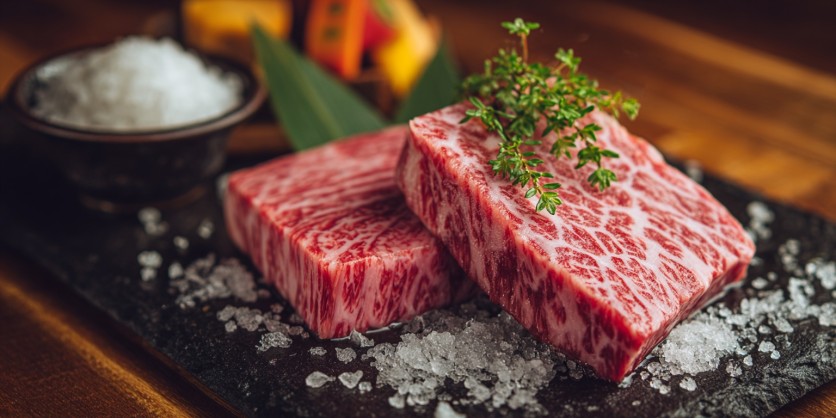Wagyu beef, renowned for its unrivaled marbling and luxurious texture, finds its roots in Japan. The term "Wagyu" literally translates to "Japanese cow," encompassing four distinct breeds: Japanese Black, Japanese Brown, Japanese Polled, and Japanese Shorthorn. These cattle were selectively bred over centuries for their endurance and ability to store energy in the form of intramuscular fat, which contributes to the signature marbling Wagyu is now celebrated worldwide.
When Wagyu genetics began to spread beyond Japan in the late 20th century, breeders in countries such as Australia and the United States recognized the potential to cultivate their own Wagyu herds. This global dispersion marked the beginning of distinct regional interpretations of Wagyu. While the original Japanese lines remained highly regulated, new breeding programs outside of Japan blended Wagyu with domestic breeds, which eventually led to uniquely Australian and American variants.
Today, Wagyu is not a monolith. Instead, it exists in nuanced forms depending on geography, breeding practices, feed protocols, and grading systems. These variables shape the flavor, texture, and cultural perception of Wagyu beef around the world, prompting comparisons between different regions, particularly between the Australian and American versions.

Breeding and Genetic Lineage
The genetic composition of Wagyu cattle is fundamental to the quality of the beef. In Japan, Wagyu is strictly purebred, and any deviation from established bloodlines is not permitted. Outside of Japan, both Australia and the United States began by importing purebred and full-blood Wagyu cattle, gradually integrating these genetics into local herds. The degree to which Wagyu blood is retained in these herds is a key differentiator between Australian and American producers.
Australian Wagyu programs often prioritize fullblood cattle—those that maintain 100 percent Japanese Wagyu genetics. This approach aligns more closely with traditional Japanese methods and has helped Australian Wagyu earn a global reputation for authenticity and quality. Many Australian ranchers are meticulous in preserving genetic purity, often using DNA testing to verify lineage and ensure compliance with breeding standards.
In contrast, the American Wagyu industry has embraced a more hybridized model. While there are fullblood Wagyu operations in the U.S., a large portion of American Wagyu is a crossbreed, typically between Wagyu and Angus. This crossbreeding results in beef that blends Wagyu's marbling with the robust flavor of Angus, creating a product that appeals to a broader consumer base. However, this hybridization means that American Wagyu often differs in texture and taste from both Australian and Japanese counterparts.
Feed, Rearing Practices, and Terroir
Feeding regimens play a significant role in the development of Wagyu beef, directly influencing marbling, tenderness, and flavor. Australian Wagyu cattle are often raised on expansive grasslands before being transitioned to a grain-based diet for 350 to 500 days, which promotes consistent marbling while maintaining animal health. The feed typically includes wheat, barley, and corn, adjusted based on climate and resource availability.
In the United States, feed protocols can vary more widely. American Wagyu cattle are generally fed a high-energy grain diet earlier and for a longer duration than their Australian counterparts, sometimes up to 600 days. This prolonged grain feeding encourages heavier marbling but can also alter the flavor profile, producing a richer, sometimes more buttery taste. These feedlot systems are influenced by the American beef industry's historical emphasis on large-scale production.
Environmental factors, often referred to as "terroir," also contribute to the distinct profiles of Australian and American Wagyu. Australia's varied climates—from the cooler southern states to the arid interior—offer a diverse landscape for cattle farming. In contrast, American Wagyu is often raised in temperate regions such as the Pacific Northwest and Midwest, where consistent weather patterns allow for year-round feeding strategies. These subtle differences in geography and husbandry contribute to the final product's uniqueness.
Grading Systems and Quality Assurance
Wagyu beef is evaluated using rigorous grading systems that differ by country. In Australia, the Meat Standards Australia (MSA) system is used, along with a specific Wagyu marbling scale ranging from 0 to 9+, where 9+ signifies exceptional marbling. These grades are determined by trained inspectors who evaluate factors such as fat distribution, meat color, and overall consistency.
American Wagyu, on the other hand, is typically graded using the USDA system, which classifies beef into categories like Select, Choice, and Prime based on marbling and maturity. However, most premium American Wagyu producers go beyond USDA standards and implement proprietary grading scales to reflect Wagyu characteristics better. This has led to the emergence of classifications such as "Gold Grade" or "Reserve," particularly in the premium retail sector.
For consumers seeking reliable quality, premium e-commerce brands like Destination Wagyu offer curated selections of American and Australian Wagyu through all-encompassing subscription plans that highlight the distinct traits of each. Their sourcing practices emphasize authenticity and traceability, enabling customers to appreciate the full spectrum of Wagyu excellence. Retailers like these provide a valuable resource for exploring the nuanced differences between regional varieties, including access to options from U.S. producers focused on crossbred Wagyu as well as cattle raised in Australia with preserved Japanese genetics, available through both specialty American selections and authentic Australian lines.
Flavor Profile and Culinary Characteristics
One of the most compelling reasons for Wagyu's global acclaim is its flavor. Australian Wagyu is known for its delicate, refined taste with subtle umami notes and a clean finish. This flavor profile is largely influenced by the breed's genetic purity and the balance between grass and grain feeding. The beef tends to be tender but with a firmer bite than Japanese Wagyu, making it ideal for both Western and Eastern cooking styles.
American Wagyu, especially the crossbred varieties, presents a bolder, beefier flavor. The higher fat content from prolonged grain feeding contributes to a rich mouthfeel and a buttery, sometimes nutty finish. While still tender, the texture is often slightly denser, giving American Wagyu a hearty appeal well-suited for steakhouse-style preparations and grilling.
Chefs and culinary professionals often choose between the two based on dish requirements. For delicate dishes like carpaccio or shabu-shabu, Australian Wagyu's subtlety shines through. In contrast, American Wagyu is often preferred for searing or grilling, where its robust flavor can be showcased with minimal seasoning. Both types offer unique culinary advantages, reinforcing the idea that Wagyu is not one-size-fits-all.
Market Positioning and Consumer Perception
The global demand for Wagyu beef has skyrocketed in recent years, and both Australian and American producers have seized the opportunity to expand their reach. Australian Wagyu enjoys strong visibility in Asia and Europe, where its perceived authenticity and alignment with Japanese standards resonate with high-end consumers. Its consistent grading and quality assurance measures lend credibility in international markets.
In the U.S., American Wagyu has carved out a loyal customer base thanks to strategic marketing, restaurant partnerships, and direct-to-consumer platforms. The crossbred nature of much of the American Wagyu supply allows for more competitive pricing, making it more accessible to everyday consumers while still offering a premium experience. This has allowed American Wagyu to penetrate both gourmet and casual dining segments.
Consumer perception is often shaped by familiarity and brand reputation. While Australian Wagyu is often associated with heritage and authenticity, American Wagyu is lauded for its bold flavor and adaptability. The market reflects this divide, with certain segments prioritizing traditional qualities and others drawn to innovation and local sourcing. Both approaches cater to different sensibilities and are vital to the global success of the Wagyu category.

Sustainability and Industry Trends
Sustainability is increasingly important in the premium beef industry, and Wagyu producers are adapting to meet these concerns. Australian producers are investing in regenerative farming, water conservation, and methane reduction technologies to minimize environmental impact. Many farms also prioritize animal welfare, ensuring that cattle are raised in low-stress environments that align with consumer values.
American Wagyu operations are also making strides in sustainability. Innovations include rotational grazing, feed optimization, and reduced antibiotic usage. Additionally, some producers are collaborating with universities and research institutions to develop more eco-friendly practices without sacrificing beef quality. These efforts reflect a broader shift toward responsible luxury, where quality and conscience coexist.
Looking ahead, the future of Wagyu beef lies in education, transparency, and culinary experimentation. As consumers become more informed about the nuances of Wagyu types, the ability to distinguish between Australian and American offerings will become a marker of sophistication. Producers who embrace sustainability while maintaining premium standards are likely to lead the next wave of Wagyu innovation.
In the end, understanding the distinctions between Australian and American Wagyu is essential for anyone seeking to appreciate the full potential of this exceptional beef. From genetics and feeding practices to grading systems and culinary characteristics, each region brings its own philosophy and flavor to the table. As global interest in premium beef continues to rise, the ability to recognize and choose between these nuanced varieties empowers consumers to make more informed, rewarding decisions at the butcher counter or dining table.
ⓒ 2025 TECHTIMES.com All rights reserved. Do not reproduce without permission.




